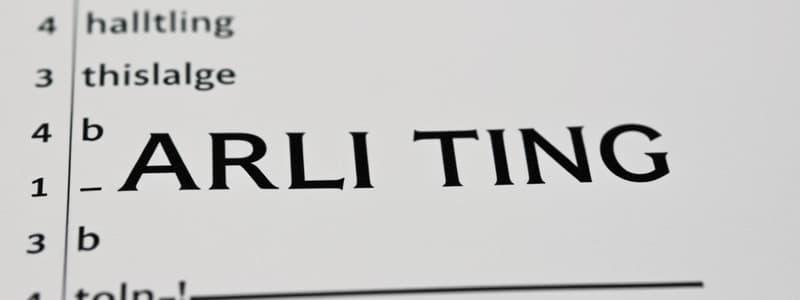Podcast
Questions and Answers
Which of the following correctly describes the family classification of the English language?
Which of the following correctly describes the family classification of the English language?
- Germanic branch of the Indo-European family (correct)
- Slavic branch of the Indo-European family
- Romance branch of the Indo-European family
- Celtic branch of the Indo-European family
What is the primary sentence structure of English?
What is the primary sentence structure of English?
- Subject-Verb-Object (SVO) (correct)
- Object-Subject-Verb (OSV)
- Subject-Object-Verb (SOV)
- Verb-Subject-Object (VSO)
How many phonemes are estimated to be in the English language?
How many phonemes are estimated to be in the English language?
- 60
- 44 (correct)
- 30
- 20
What aspect of writing in English often leads to inconsistency?
What aspect of writing in English often leads to inconsistency?
Which of the following is a characteristic of American and British English differences?
Which of the following is a characteristic of American and British English differences?
Which of the following methods is NOT commonly used for word formation in English?
Which of the following methods is NOT commonly used for word formation in English?
What does the term 'loanwords' refer to in the context of the English language?
What does the term 'loanwords' refer to in the context of the English language?
Which of the following is considered a global variant of English?
Which of the following is considered a global variant of English?
Flashcards are hidden until you start studying
Study Notes
Overview of English Language
-
Language Family:
- Part of the Germanic branch of the Indo-European language family.
-
Global Use:
- Widely spoken as a first language (native speakers) and as a second language (non-native speakers).
- Official language in numerous countries and international organizations.
Phonetics and Phonology
-
Phonemes:
- English has around 44 phonemes, including consonants and vowels.
-
Stress and Intonation:
- Stress patterns can change the meaning of words (e.g., 'record' as a noun vs. 'record' as a verb).
- Intonation conveys emotion and indicates questions or statements.
Grammar
-
Parts of Speech:
- Nouns, verbs, adjectives, adverbs, pronouns, prepositions, conjunctions, interjections.
-
Sentence Structure:
- Basic structure follows Subject-Verb-Object (SVO) order.
-
Tenses:
- Present, past, and future tenses with simple, continuous, perfect, and perfect continuous aspects.
Vocabulary
-
Word Formation:
- Derivation, compounding, and blending are common methods of creating new words.
-
Loanwords:
- English incorporates many loanwords from languages like Latin, French, and Spanish.
Writing System
-
Alphabet:
- Uses the Latin alphabet with 26 letters.
-
Spelling:
- Often inconsistent due to historical influences and borrowing from other languages.
Dialects and Variants
-
British vs. American English:
- Differences in spelling (e.g., "colour" vs. "color"), vocabulary (e.g., "lift" vs. "elevator"), and pronunciation.
-
Global Variants:
- Includes Australian, Canadian, Indian, and Caribbean English, each with unique features.
Literature and Culture
-
Historical Development:
- Old English (5th-11th centuries), Middle English (11th-15th centuries), Modern English (15th century-present).
-
Notable Authors:
- William Shakespeare, Jane Austen, Charles Dickens, and contemporary writers like J.K. Rowling.
Linguistic Trends
-
Language Evolution:
- Continuous evolution influenced by technology, social media, and globalization.
-
Emerging Dialects:
- New English varieties developing in multilingual contexts, such as 'Singlish' in Singapore.
Learning Resources
-
Courses:
- ESL (English as a Second Language), EFL (English as a Foreign Language).
-
Media:
- Books, movies, podcasts, and online platforms enhance language learning and comprehension.
Overview of English Language
- Part of the Germanic branch of the Indo-European language family.
- Spoken globally, both as a native language and a second language.
- Official language in numerous countries and organizations.
Phonetics and Phonology
- Approximately 44 phonemes exist, comprising consonants and vowels.
- Stress can alter word meanings, exemplified by 'record' as a noun and verb.
- Intonation reflects emotion and distinguishes between questions and statements.
Grammar
- Consists of eight parts of speech: nouns, verbs, adjectives, adverbs, pronouns, prepositions, conjunctions, and interjections.
- Follows a Subject-Verb-Object (SVO) structure in sentences.
- Uses various tenses: present, past, and future, along with simple, continuous, perfect, and perfect continuous aspects.
Vocabulary
- New words form through derivation, compounding, and blending.
- Includes many loanwords, primarily from Latin, French, and Spanish.
Writing System
- Comprises the Latin alphabet with 26 letters.
- Inconsistent spelling influenced by historical factors and language borrowing.
Dialects and Variants
- British and American English differ in spelling (e.g., "colour" vs. "color") and vocabulary (e.g., "lift" vs. "elevator").
- Features global variants, including Australian, Canadian, Indian, and Caribbean English, each with distinct characteristics.
Literature and Culture
- Historical development includes Old English (5th-11th centuries), Middle English (11th-15th centuries), and Modern English (15th century to present).
- Notable authors include William Shakespeare, Jane Austen, Charles Dickens, and contemporary writers like J.K. Rowling.
Linguistic Trends
- Continuously evolving due to technology, social media, and globalization.
- Emergence of new dialects in multilingual contexts, such as 'Singlish' in Singapore.
Learning Resources
- Courses available for English as a Second Language (ESL) and English as a Foreign Language (EFL).
- Diverse media resources such as books, movies, podcasts, and online platforms support language learning and comprehension.
Studying That Suits You
Use AI to generate personalized quizzes and flashcards to suit your learning preferences.




